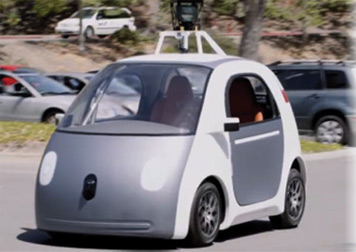A car without a steering wheel and brake pedal
On May 27, the public got a chance to see and try out the prototype
of the "driverless" Google car . What was it like, riding it?
Two people got in the prototype, buckled up, and used a smartphone
app (or pretended to) to tell the car where they wanted to go. The
Google car has no steering wheel, no brake pedal, no accelerator, no
park-forward-reverse - so the two passengers knew immediately they would
ride in the car, not drive it.
One of them pushed the "start" button, and the car took them to the
street address they gave it.
 When they arrived at their destination, the car turned itself off -
or the passengers pressed the "stop" button - and the trip was over. When they arrived at their destination, the car turned itself off -
or the passengers pressed the "stop" button - and the trip was over.
The takeaway? Here's one: The Google self-driving car will take you
to work - but if you want to stop for dough nut on the way, you'll have
to instruct the car through your smartphone to pause on its trip to your
office - then begin a new trip into the dough nut shop parking lot and
park - then leave the parking lot, and resume the trip to your office.
The Google prototype is the first 100 percent "self-driving," or
"autonomous" car.
What is different about the Google car is that it is 100 percent
self-driving. There is no steering wheel, no brake pedal, no
accelerator. If you were riding in the car, you couldn't drive it if you
wanted to.
Google, in statements released May 27 when it showed its prototype to
the public, said it decided allowing a rider in the car to "seize
control" of the car in an apparent emergency would merely increase the
danger to the car and its riders. So it removed the steering wheel, and
other controls, so the passengers could play no role in driving the car.
How does the Google car know what road to take, where to turn, and
how to get to the destination the rider gives it? It follows Google's
highly detailed maps, loaded into its software. During the trip, it uses
a global positioning satellite feed and its radar, sensors and lasers to
confirm its exact position on the map.
Every stop sign, traffic light, one-way sign is on the map, and the
car's sensors monitor everything that moves or is on the roads nearby
for 600 feet or so in every direction, so the car will always avoid
hitting another vehicle, a bicycle, or a pedestrian.
For the time being, the car will go no faster than 25 miles per hour.
Google does not contemplate the car being used on the highways to drive
from one city to another.
And Google's progress so far? It says it will build 100 prototypes
and test them on public roads starting in late summer, 2014.
At some point in 2015 or beyond, Google will begin to sell the cars
for use where the law permits. To date, four U.S. states allow the
testing of self-driving cars on public roads: California, Nevada,
Florida, and Michigan.
Where the Google car will have no steering wheel or other controls
for a driver to use, the auto makers will keep the driver in charge of
their self-driving cars.
And that is the greatest difference between the Google car, and all
the other self-driving cars under development. The auto makers will
retain the steering wheel and other driving controls, and add
"self-driving" features to their standard production cars.
What are some examples of "self-driving features?" Volvo says its
prototypes so far can "safely follow a car down the street, adjust the
car's speed, and merge, all without the driver's assistance." Volvo says
it hopes to have some ordinary drivers as well as experts working with
its first "autonomous car" in Gothenburg, Sweden, where Volvo is
located, in 2017.
At Mercedes, the company says the autonomous sedan, like the Google
car, will be "completely" autonomous, although it will keep the steering
wheel, brake pedal, accelerator, and other driver controls, and the
driver will remain the driver - and remain in command of the car.
Like the Google car, the Mercedes car will follow detailed maps of
the roads and highways the car will be traveling - and Daimler touts its
progress so far, boasting that already its autonomous sedan has been
able to follow, without the driver's help, the same sixty-mile route
between Mannheim and Pforzheim that Bertha Benz drove "more than 125
years ago when she set off on the world's first long-distance drive."
Mercedes says it would like to see its self-driving cars in
production by 2020. It adds that an essential part of any completely
self-driving car will be accurate and detailed maps. Google, of course,
already has the maps that Mercedes needs.
- HITC |

